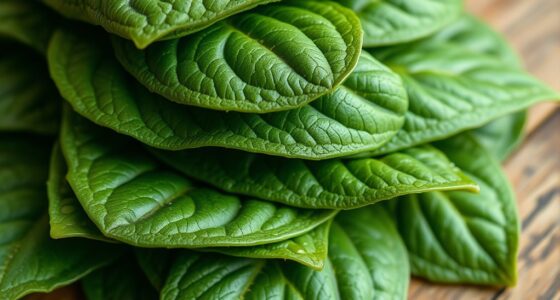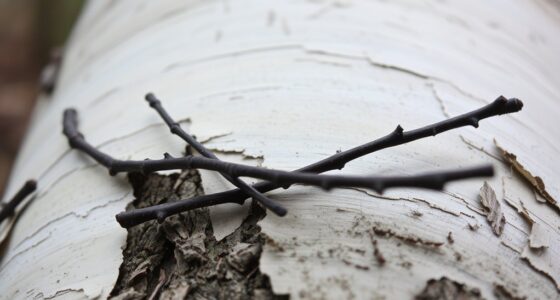To get the most potent valerian root, harvest it in late summer or early fall, just before the foliage starts to yellow or die back. Look for roots that are firm and fragrant, signaling peak active compounds. Carefully dig around the plant and lift out the roots without damage. Dry them by cutting into smaller pieces and air-drying in a cool, well-ventilated spot. Properly stored, your valerian roots will maintain their calming properties—learn more to perfect your harvest and drying techniques.
Key Takeaways
- Harvest valerian roots in late summer or early fall, just before foliage yellowing or dying back begins.
- Ensure roots are firm and fragrant, indicating peak potency and readiness for harvest.
- Use a garden fork or spade to carefully loosen soil and lift roots without damage.
- Dry roots by cutting into smaller pieces and air drying in a well-ventilated, shaded space or using a low-temperature dehydrator.
- Store dried valerian roots in airtight containers in a cool, dark place to preserve their medicinal properties.

Valerian root is a natural herbal supplement commonly used to promote relaxation and improve sleep quality. When you’re ready to harvest this powerful herb, understanding the right timing and techniques can make all the difference in revealing its full potential. You want to maximize its potency, so paying attention to harvesting methods and drying techniques is essential. The goal is to gather the roots when they’re at their peak strength, guaranteeing you get the most benefits from your efforts.
Timing is vital. Typically, you should harvest valerian roots in late summer or early fall, just before the plant begins to decline. This is when the roots have stored the highest concentration of active compounds. To determine the ideal moment, look for signs of maturity, such as the plant’s foliage yellowing or dying back. The roots should be firm and fragrant—these are indicators that they’re ready for harvest. If you wait too long, the potency diminishes, and you could end up with a weaker product. Harvesting at the right time guarantees you’re capturing the full essence of the herb’s calming properties. Additionally, understanding harvest timing ensures you are collecting the roots when they are most potent.
Harvest valerian roots in late summer or early fall for maximum potency and calming benefits.
When it comes to harvesting methods, you want to be gentle yet thorough. Carefully dig around the base of the plant, avoiding damage to the roots. Use a garden fork or spade to loosen the soil without tearing the roots apart. Gently lift the entire root ball, removing as much soil as possible. Rinse the roots with cool water to clear off dirt and debris, but don’t soak them. The goal is to keep the roots intact and clean for drying. Proper handling during harvest preserves the herb’s potency and guarantees a quality end product.
Drying techniques are just as essential as harvesting correctly. Once cleaned, cut the roots into smaller pieces to promote even drying. You can use air drying, which involves spreading the root pieces on a screen or mesh in a warm, well-ventilated space out of direct sunlight. This method helps retain the herb’s active compounds. Alternatively, if you prefer a quicker process, a dehydrator set at a low temperature works well. Avoid high heat or direct sunlight, which can degrade the roots’ medicinal qualities. Proper drying reduces moisture content, preventing mold and rot, and extends the shelf life of your valerian. Store the dried roots in airtight containers in a cool, dark place to preserve their calming properties for months.
Frequently Asked Questions
Can Valerian Root Be Harvested in Different Climates?
Yes, you can harvest valerian root in different climates. Its climate adaptability means you can adjust harvest timing based on your local conditions. In warmer climates, wait until the plant’s roots are fully mature, usually after flowering. In cooler areas, monitor the plant closely, harvesting when the roots have developed strong, aromatic qualities. Embrace your environment and liberate yourself from rigid schedules—trust nature’s rhythm for the best valerian harvest.
How Does Soil Type Affect Valerian Root Potency?
You might think soil type doesn’t matter, but it greatly influences valerian root potency. Rich, fertile soil boosts root maturation, leading to stronger, more effective valerian. When soil lacks nutrients, roots remain underdeveloped, weakening their calming properties. You have the power to choose or improve your soil, revealing the full potential of valerian. Embrace the liberation of understanding how soil fertility directly enhances root strength and medicinal benefits.
Is It Necessary to Use Organic Methods When Harvesting?
You don’t have to use organic methods when harvesting valerian root, but choosing organic certification guarantees you avoid pesticide residue, supporting a cleaner, more natural product. It’s about liberation from harmful chemicals, letting you enjoy the herb’s true potency and purity. Organic practices empower you to harvest with integrity, knowing you’re respecting nature’s balance and providing a safer, more authentic root experience for yourself and others.
What Are Common Pests That Attack Valerian Plants?
Pests like aphids, spider mites, and beetles can sneak in like unwelcome guests, threatening your valerian’s essentialness. To maintain plant health and keep these pests at bay, practice pest prevention by regularly inspecting your plants and encouraging natural predators. Liberate your valerian from damaging pests by staying vigilant, ensuring your plants stay strong and healthy, so they can thrive free of unwanted invaders.
How Long Does the Drying Process Typically Take?
The drying process usually takes about 2 to 4 weeks, depending on humidity and your harvest timing. You want to guarantee your valerian root is thoroughly dried for maximum potency and storage life. Keep the roots in a well-ventilated, dry space, and turn them regularly. Once they’re brittle and break easily, you’ve achieved ideal drying duration, freeing your herbs to be used whenever you desire.
Conclusion
When you harvest valerian root at the right time, you guarantee its potency and quality, much like picking ripe fruit at its peak flavor. Proper drying then preserves its calming properties, keeping it fresh and effective. Think of it as catching a fleeting breeze—timing and care make all the difference. With patience and attention, you’ll enjoy the soothing benefits of valerian root, just as a gentle lullaby eases you into restful sleep.










